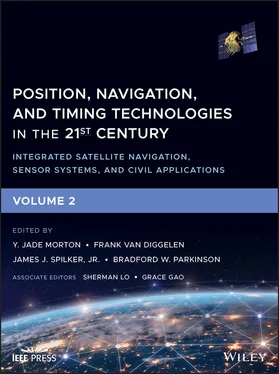20 Chapter 52Figure 52.1 Plaque attached to the face of the Pioneer 10 (1972) and 11 (197...Figure 52.2 The Unconventional Stellar Aspect (USA) instrument located on th...Figure 52.3 Example X‐ray photon intensity profile of Crab Nebula pulsar, PS...Figure 52.4 Example X‐ray photon intensity profile of pulsar PSR B1509‐58 wi...Figure 52.5 Neutron star with separate rotation and magnetic axes (Sheikh [2...Figure 52.6 Crab Nebula and Pulsar (PSR B0531+21) in the X‐ray band as obser...Figure 52.7 Several types of X‐ray celestial sources plotted along the Galac...Figure 52.8 Comparisons of two GRB measurements for GRB080727B using two sep...Figure 52.9 Pulse arrivals from distant individual pulsars as they arrive at...Figure 52.10 Range vectors from a single pulsar to Earth and spacecraft loca...Figure 52.11 Doppler frequency tracking of Crab Pulsar in RXTE orbit (Golsha...Figure 52.12 Position of spacecraft as pulses enter the solar system from a ...Figure 52.13 Relative navigation between two spacecraft observing the same v...Figure 52.14 Observation of GRB by cooperating base station and remote space...Figure 52.15 ROSAT Bright catalog source plots in right ascension and declin...
21 Chapter 53Figure 53.1 Illustration of two basic spatial reference frames (Proulx et al...Figure 53.2 Illustration of path integration, or “dead reckoning” (Chiswick ...Figure 53.3 Overview of single unit recording from place cells in the rat hi...Figure 53.4 Firing patterns for four different spatial cells. For the head d...Figure 53.5 Basic Morris Water Maze experimental setup (Samueljohn.de (own w...Figure 53.6 Mid‐line sagittal view of the human cerebral cortex illustrating...Figure 53.7 Overview of three different proposed network models of allocentr...Figure 53.8 Place field in the 3D environment of a flying bat
22 Chapter 54Figure 54.1 Examples illustrating the fascinating diversity and impressive s...Figure 54.2 ASchematic of the path of the sun through the sky. In the Northe...Figure 54.3 ABirds use the rotational center of the stars to infer a polewar...Figure 54.4 Schematic of Earth’s geomagnetic field, which in essence resembl...Figure 54.5 Birds use a magnetic inclination compass. Depicted is the scenar...
23 Chapter 55Figure 55.1 Caterpillar excavator equipped by Trimble’s GNSS‐based guidance ...Figure 55.2 Mansoura Bridge, Egypt: (a) view, (b) GNSS monitoring system’s b...Figure 55.3 Measured and smoothed relative time series of the movements of M...Figure 55.4 Tide gauge station at Waikelo (Sumba, Indonesia) with a GNSS ant...Figure 55.5 Relationships between the sensors, MMS, and mapping coordinate f...Figure 55.6 Commercial UAV mapping systems: (a) Leica Aibot X6 and (b) Trimb...Figure 55.7 Components of a Pegasus backpack MMS.Figure 55.8 V10 imaging rover: (a) rover components, (b) application in an i...
24 Chapter 56Figure 56.1 Straight rows of soybeans planted with an RTK‐GPS auto‐steered t...Figure 56.2 Manual soil sampling is labor intensive; however, the capital co...Figure 56.3 Machine‐aided soil sampling system. This is part of the Soil Inf...Figure 56.4 A soil sampling for a field will result in many maps, one map fo...Figure 56.5 Prescription nitrogen map. This map is converted to a rate contr...Figure 56.6 VR phosphorous map. Each nutrient as determined by the informati...Figure 56.7 Seeds are planted at their optimum plant density to maximize pro...Figure 56.8 VR planter with electric motor drives. This type of planter can ...Figure 56.9 Without planter section control, double planting of seeds at the...Figure 56.10 With planter section control, double planting of seeds at the e...Figure 56.11 Yield map. The color differences indicate differences in yield....Figure 56.12 Land leveling with a high‐vertical‐accuracy RTK GNSS which is u...Figure 56.13 Map showing variable rate (VR) zone prescription. Different soi...Figure 56.14 Example scatter plot of positions recording for 24 hours using ...
25 Chapter 57Figure 57.1 One of the first PDA‐based navigation products, 2002.Figure 57.2 TomTom GO Portable Navigation Device, 2004.Figure 57.3 Fitbit activity tracker, measures steps, stairs, and sleep (2013...Figure 57.4 Pebble smartwatch (2013).Figure 57.5 Apple smartwatch (2016).Figure 57.6 The wearable body‐mapping sleeve.Figure 57.7 Intel MICA bracelet (2014).Figure 57.8 Photoplethysmogram (PPG).Figure 57.9 MEMS microcantilever resonating inside a scanning electron micro...Figure 57.10 Example of an MEMS gyroscope.Figure 57.11 Acceleration data from the x‐axis of an accelerometer generated...Figure 57.12 Acceleration data combined from all axes.Figure 57.13 TomTom device with OHR sensor (2016).Figure 57.14 Commonly accepted BMI ranges.Figure 57.15 Temp Traq temperature sensor patch (2015).Figure 57.16 Comparison of wireless technologies (numbers are indicative).Figure 57.17 Global wearables forecast 2014–2020.
26 Chapter 58Figure 58.1 Accuracy of an automated steering farm tractor using differentia...Figure 58.2 Path generation using a GPS‐guided John Deere tractor.Figure 58.3 Stanford Team with the GPS‐guided John Deere tractor.Figure 58.4 GNSS‐guided farm tractor performing precision tilling in Auburn,...Figure 58.5 GNSS control of a towed implement (Bevly and Parkinson [15])....Figure 58.6 Precision planting (no marker arms required).Figure 58.7 Cooperative farm operation (combine unloading onto grain cart du...Figure 58.8 Example of precision crops (left) post planting and (right) pre‐...Figure 58.9 Follow‐up farm operations of (left) cultivating and (right) harv...Figure 58.10 Concept autonomous tractors from Case IH and John Deere.Figure 58.11 Example vehicles from the inaugural DARPA Grand Challenge.Figure 58.12 First DARPA Grand Challenge course and finishing position for a...Figure 58.13 Images from the First DARPA Grand Challenge.Figure 58.14 Route for the second DARPA Grand Challenge race.Figure 58.15 Oshkosh TerraMax at the finish line of the second DARPA Grand C...Figure 58.16 Google self‐driving Prius with a roof‐mounted Velodyne LiDAR an...Figure 58.17 Automated vehicle legislation across the United States as of De...Figure 58.18 GPS velocity measurements from a static receiver.Figure 58.19 GPS velocity direction of travel measurement accuracies as a fu...Figure 58.20 Schematic demonstrating the use of multiple antennas on a body ...Figure 58.21 Attitude accuracy as a function of antenna baseline spacing.Figure 58.22 Stanford's autonomous racing Audi with dual antennas for high d...Figure 58.23 Automated truck convoys utilizing dual antennas for vehicle hea...Figure 58.24 Multiple antennas for correcting GNSS positions at the roof to ...Figure 58.25 Carrier‐phase differential GNSS exploits the temporal and spati...Figure 58.26 Platooning with short separation distances is possible with hig...Figure 58.27 Spatial and temporal differential GNSS techniques can be levera...Figure 58.28 Current and previous positions of the lead and following vehicl...Figure 58.29 Comparison of single‐frequency (L1) and dual‐frequency (L1/L2) ...Figure 58.30 An autonomous vehicle can use Dynamic base Real Time Kinematic ...Figure 58.31 Plot of single‐frequency (L1) and dual‐frequency (L1/L2) mean i...Figure 58.32 Plot of the integer ratio test result for single‐frequency and ...Figure 58.33 Plot of the stability of the east or north components of three ...Figure 58.34 Plot of the stability of the stand‐alone GPS (red) and TDCP (bl...Figure 58.35 Planar vehicle model schematic.Figure 58.36 Schematic of lateral tire forces versus tire slip angle of a ty...Figure 58.37 Longitudinal tire force versus longitudinal slip under various ...Figure 58.38 Auburn University Infiniti G35 equipped with IMU, CAN measureme...Figure 58.39 Vehicle yaw rate (left) and side slip (right) during a driving ...Figure 58.40 GPS velocity compared to wheel speed derived velocity and the r...Figure 58.41 Longitudinal force (estimated from longitudinal acceleration) v...Figure 58.42 GNSS‐based estimation of tire radius for various tire pressures...Figure 58.43 GPS/INS block diagram.Figure 58.44 Plot of GPS and GPS/INS course accuracy as a function of vehicl...Figure 58.45 Multi‐antenna GPS and multi‐antenna GPS/gyro attitude accuracy ...Figure 58.46 Vehicle steering wheel angle (at the handwheel) and yaw rate fo...Figure 58.47 GPS/INS‐estimated vehicle (and error) from the double‐lane‐chan...Figure 58.48 GPS/INS‐estimated vehicle roll (and error) from the double‐lane...Figure 58.49 Plot of estimated and measurement vehicle position in the geode...Figure 58.50 GPS/INS‐estimated side slip during the maneuver shown.Figure 58.51 Tire force on an asphalt surface.Figure 58.52 Tire force on a gravel surface.Figure 58.53 Block diagram of a Kalman filter that utilizes both IMU measure...Figure 58.54 Plot of east and north IMU dead‐reckoning solution with no cons...Figure 58.55 Plot of the horizontal error with respect to the reference solu...Figure 58.56 Plot comparing the estimated longitudinal speed derived from IM...Figure 58.57 Block diagram of Kalman filter‐based navigation system fusing G...Figure 58.58 Plot of stand‐alone GPS (red), GPS/INS (blue), and GPS/INS/VDM ...Figure 58.59 Block diagram of a Kalman‐filter‐based navigation system fusing...Figure 58.60 Conceptual depiction of the four scans of the LiDAR that are us...Figure 58.61 Plot of navigation solutions for stand‐alone GPS, GPS/INS, and ...Figure 58.62 Road map lateral constraints and satellite signal with line‐of‐...Figure 58.63 Picture of urban canyon showing that the line of sight in the l...Figure 58.64 Plot of lateral lane position estimates using only GPS/INS with...Figure 58.65 Plot of lateral lane position estimates using GPS/INS and visio...Figure 58.66 Plot of longitudinal position error of the navigation system us...Figure 58.67 Plot of longitudinal position error of the navigation system us...Figure 58.68 Plot of the estimated vehicle position using only INS and LiDAR...Figure 58.69 Plot of north and east position errors of the navigation soluti...Figure 58.70 Plot comparing pseudorange only (red), GPS/INS (yellow), and GP...Figure 58.71 Plots comparing vector tracking GPS receiver position estimates...Figure 58.72 Auburn University demonstration of truck platooning at 50 foot ...Figure 58.73 States having passed legislation allowing close gap truck plato...Figure 58.74 Fuel savings results versus gap spacing from an SAE Type 2 fuel...Figure 58.75 Delphi electronically scanning radar range compared to Dynamic ...Figure 58.76 Auburn University’s NCAT test track demonstrating loss of range...Figure 58.77 Output for the 64 Channel Delphi Electronically Scanning Radar ...Figure 58.78 Dynamic base Real Time Kinematic (DRTK)‐based classification of...Figure 58.79 GPS‐estimated road grade and resulting following distance error...Figure 58.80 GPS‐estimated road grade and resulting following distance error...Figure 58.81 GPS road grade estimate compared to the profilometer‐measured r...Figure 58.82 Spoofing detection algorithm based on radar ranges versus GPS‐g...Figure 58.83 Conceptual diagram showing the selection of the desired aiming ...Figure 58.84 The desired following vehicle heading ( Ψ R) is calculated u...Figure 58.85 Diagram showing the experimental setup for the lead and followi...Figure 58.86 Plots of the paths of the lead and following vehicle during tes...Figure 58.87 Plot of total lateral path error (gray) and the reference path ...
Читать дальше











